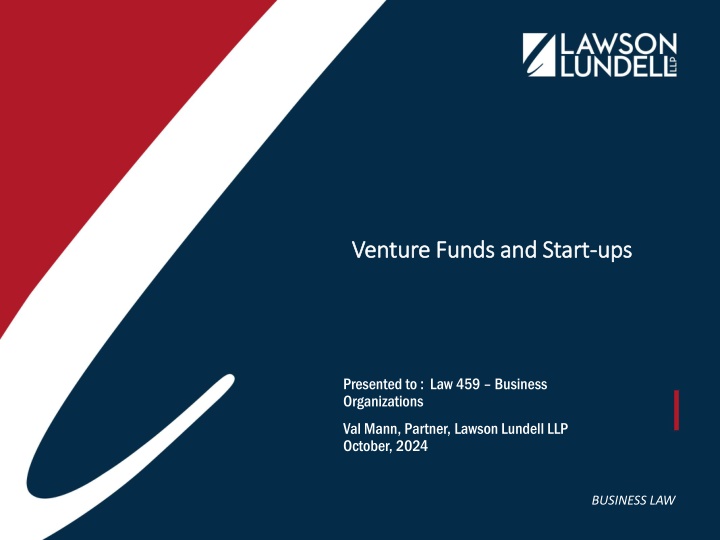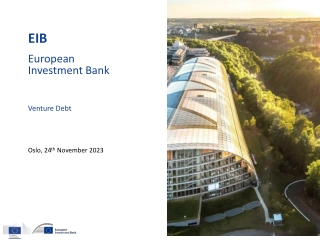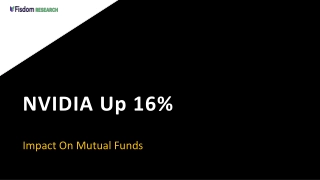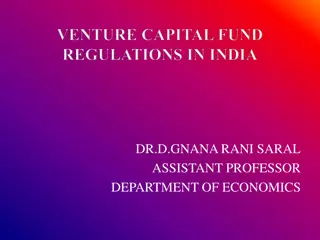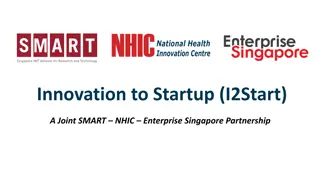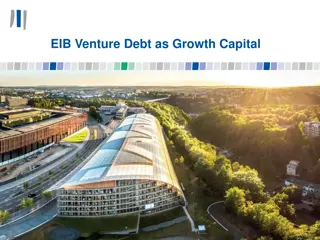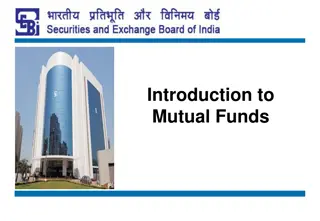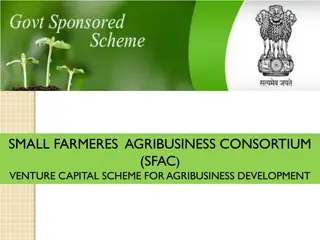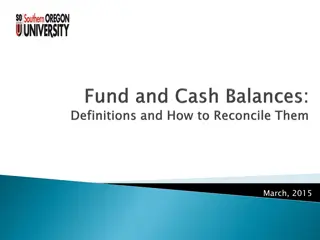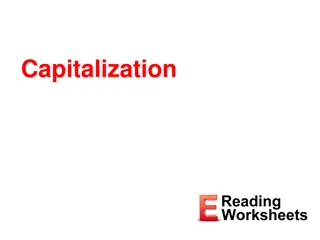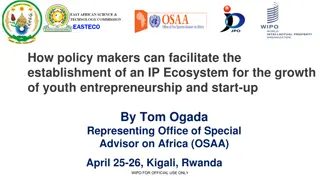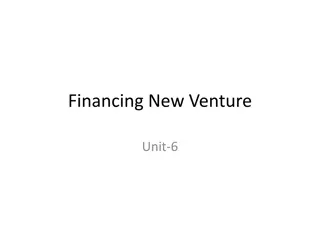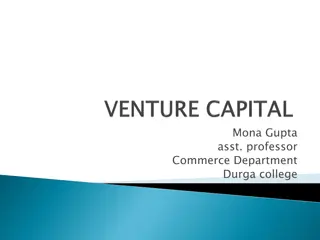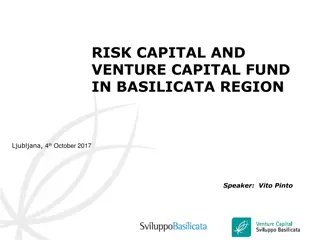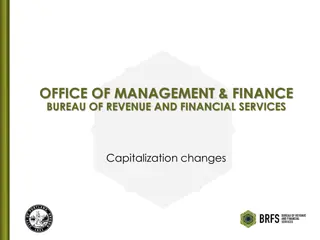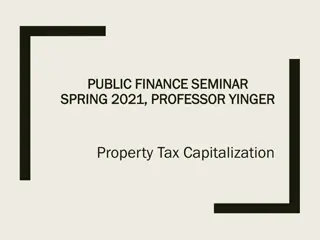Venture Funds and Start-ups: Capitalization, Structures, Ecosystem, Funding, Alignment
This presentation delves into the world of venture funds and start-ups, exploring their capitalization, core structures, place in the entrepreneurial ecosystem, funding sources, and the theory of alignment between companies and investors. It also touches on the aims, challenges, and outcomes for both funds and founders in the dynamic venture capital landscape.
Download Presentation

Please find below an Image/Link to download the presentation.
The content on the website is provided AS IS for your information and personal use only. It may not be sold, licensed, or shared on other websites without obtaining consent from the author.If you encounter any issues during the download, it is possible that the publisher has removed the file from their server.
You are allowed to download the files provided on this website for personal or commercial use, subject to the condition that they are used lawfully. All files are the property of their respective owners.
The content on the website is provided AS IS for your information and personal use only. It may not be sold, licensed, or shared on other websites without obtaining consent from the author.
E N D
Presentation Transcript
Venture Funds and Start Venture Funds and Start- -ups ups Presented to : Law 459 Business Organizations Val Mann, Partner, Lawson Lundell LLP October, 2024 BUSINESS LAW
Agenda Capitalizing an enterprise What is a Venture Fund What is a fund s core purpose How is it structured
Agenda Start-ups / growing companies Why Venture? Common Structures Common Shares Convertible Debt SAFEs Preferred Shares
What place does Venture hold in the ecosystem? Venture capital = step in private capital raise Progression: Credit cards Friends and family Moving back into your parents home and asking friends to help code. . Then to real investment: Seed minor, high risk, early stage investments Early stage prototype support, marketing support Later stage expansion, commercialization
Sources of Funding Startup Funding Landscape Concept Prototype Alpha/Beta Minimum Viable Product (MVP) Traction Revenue Break-Even Point Exit FOUNDERS FRIENDS & FAMILY VC FUNDS CROWD-FUNDING PRIVATE EQUITY ANGEL INVESTORS / FAMILY OFFICES CORPORATE VC SEED FUNDS IPO / DEBT ACCELERATORS DEBT / VENTURE DEBT GRANTS / TAX CREDITS / GOVERNMENT PROGRAMS Idea Growth Mature Start-up
Theory of Alignment Shared goal of driving business growth and maximizing returns Company / founders leverage experience and networks of VC Rapid growth/ability to scale Returns of VC/investors are tied to success of venture high risk/high return
To the Fund It s all about the returns ..
To the founder its about scale and exit Scaling with growth capital = Will make founders into fat cats
Doesnt always work out that way October 21 G&M reported Georgian Partners wrote down US$430M in value (28 investments in 21 companies over 5 funds) Investors in Georgian BDC, EDC as well as large privates Tough environment for a raise.
Is it all ethical? Lack of diversity in VCs Lack of diversity in their investments / portfolios Less than 2% of total venture dollars went to women-led companies in 2022/23 Backlash in the US against woke capitalism eroding ESG initiatives BlackRock (4T AUM) cut support for ESG shareholder proposals from 47% in 2021 to 4% in 2023 AI mitigation against negative impact of tech
More than just IRR Impact funds Look for investments with more than just financial return Reporting to VC VC reporting on impact to investors
The Raise Fund sponsor raises funds from sophisticated investors high net worth, institutional investors, government funds, foundations Investors are looking for a return on their capital that is greater than achievable in publicly traded shares Fund invests in 10-20 companies over five years and then spends another 5 growing them and commercializing/stabilizing the business and then exit Return the capital at the 10 year mark
Venture Funds VCs are typically formed as limited partnerships. Investors subscribe for interest in LP VCs are run by general partners GPs raise funds from passive investors and invest in private companies. As investment opportunities arise, they will call for capital from their investors to (i) aggregate sufficient funds to complete the investment; and (ii) pay their fees. Looking for growth potential.
Typical structure Limited Partners Manager General Partner Equity Ownership Fund Management VC Fund (Limited Partnership) Investment Investment Investment
Limited Partnerships Flexible not bound by the same restrictions as corporations Complex the rules are set by contract Can call capital over time investors subscribe by making a commitment Can design the return to investors in a waterfall Are efficient for tax purposes for investors flow through Limited liability for investors (passive investors no involvement in the business)
Companies go shopping Start-ups / growth/scale companies seeking capital Looking for Capital VCs in their investment period meaning they have not called all their capital, and are looking for investments 100:1 rule Fit within a sector focus
Early Stage Financing Structures SAFEs? Source: NACO Angel Investing Activity in Canada Report 2018
Preparing for Financing Initial Cap Table Name Position Common Shares Investment % Basic % Fully Diluted Founder 1 Co-Founder 4,000,000 $40.00 43.13% 37.50% Founder 2 Co-Founder 3,000,000 $30.00 32.35% 28.13% Founder 3 Co-Founder 2,000,000 $20.00 21.56% 18.75% Investor 1 Investor 125,000 $25,000.00 1.35% 1.17% Investor 2 Investor 150,000 $30,000.00 1.62% 1.41% Basic Totals 9,275,000 $55,090.00 100% 86.96% ESOP: Authorized Pool 1,391,250 13.04% Issued 600,000 5.63% Available 791,250 7.42% Fully Diluted Totals 10,666,250 100%
Preparing for Financing Understanding Valuations Dependent on a number of variables First time founders vs prior successful exits Traction Revenue/ Profits Size of market opportunity Where company is based Where investors are based Market conditions Comparable companies / deals Note: Higher valuation in early rounds not necessarily better and can cause issues in subsequent rounds if too high
Common Shares Possible Terms What might be negotiated? 1. Valuation Based on Capitalization Pre-and Post-Money Fully Diluted Option Pool 3. Special Rights Information Pre-emptive ROFR Co-Sale 4. Founder Reverse Vesting
Convertible Debt Financing: Key Terms Basic Terms Negotiated 1. Amount 2. Maturity Date Typically 3 years or less Fact specific 3. Interest Rate 4. Conversion to Equity Valuation Cap Discount Qualified Financing M&A Forced Conversion / Optional Conversion
Convertible Note/Debt Financing: Other Considerations Other Terms Include 1. Security (or lack of) 2. Protective Provisions Consent rights on major corporate or business matters? 3. Information Rights Access to Periodic Information? 4. Pre-emptive Rights 5. Most Favoured Nation (MFN)
Simple Agreements for Future Equity (SAFEs): Key Terms 1. Amount 2. Conversion to Equity Valuation Cap Discount (typically 20%) Qualified Financing Trigger 2. Other Pre-emptive rights MFN Information rights Special approvals
Pref Shares Preferred shares are most often negotiated at the VC stage (not as much at an earlier round) Will not be a class of shares that exists before the VC comes along Lead negotiator (largest VC) on a financing round Will have certain rights to reflect the risk/reward of investing in early stage
Preferred Share Financing: Exit preference Liquidation Preference: holders of preferred shares must be paid a stated amount prior to the distribution of any proceeds to the common shareholders upon a liquidation event Non-Participating Preferred: holders must choose between receiving the liquidation preference or converting to common shares in order to share pro rata in the total proceeds Participating Preferred: holders not only receive the liquidation preference, but also participate with the common shareholders on an as-if-converted basis HybridPreferred: holders have a cap such that the preferred shares will stop participating once they have received a total amount equal to some multiple of the original purchase price or can choose to convert and share pro rata
Preferred Share Financing: Anti-dilution Full-Ratchet anti-dilution protection lowers the conversion price to the price at which any new shares are sold Forces common shareholders to absorb most of dilution Weighted Average anti-dilution protection adjusts the conversion price according to the relative percentage of ownership that is being sold at the lower price
Resources and Links NVCA Model Documents (US) CVCA Model Documents (Canadianized) NACO Common Docs Small Business Venture Capital Act Programs Policy Statement on SAFE Eligibility
EBC Tax Credits Direct Investments Tax credits under the Small Business Venture Capital Act under the EBC and VCC programs 30% refundable tax credit for investors Eligibility Incorporated in BC or Federally Connection to BC 75% wages to BC employees 80% of assets in BC Permanent presence in BC Investor must be a BC resident Substantially engaged in qualifying activities Less than 100 employees (including affiliates) Minimum equity capital: $25,000 SAFEs eligible (with certain revisions MUST be pre- cleared) Convertible debt not eligible
VCC Tax Credits Portfolio Investments Eligibility Newly Incorporated in BC VCC s sole purpose is raising capital to invest in the Eligible Small Business (ESB) VCC must raise a minimum equity capital: $50,000 ESBs must be substantially engaged in a qualifying activity Activities include: proprietary tech, digital media, clean tech ESBs must pay 75% wages to BC employees (50% if exporting) SAFEs (with revisions) and Equity Limited ability to do convertible debt transactions SAFEs and convertible debt should be pre-cleared
Common Share Financing: EBC/VCC Tax Credits Restrictions Maintain eligibility for 5 years Investor must hold securities for 5 years Maximum equity capital under program: $5m Must be arms-length investors Restrictions on how money is spent Investor must not have sold shares of the company
